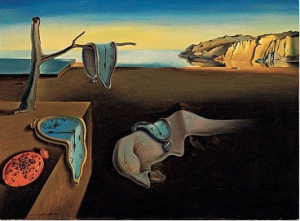If I were to describe my week, it would be “busy”. Insanely busy. Thus, I decided that for this blog post, I would find a piece of artwork that focused on the aspect of time. Which lead me to finding about this painting by the Spanish artist Salvador Dali called The Persistence of Memory. At a first glance, I would say that this painting is rather interesting. It raised a lot of questions. What did the melting clocks mean? That time is limited? And why do the cliffs in the background seem to stand out so much? What is the red oval in the in the far left corner of the painting? What are the small, black dots on it? How about the figure in the middle? Is it a horse? A rock? A bush? These questions essentially led me to do some research.
According to legomenon.com, the artist himself described it as “hand-painted dream photographs” (Shabi). This relation of the artwork and dreams seem to make sense. If we look at the painting, we can see different things that could suggest a setting of a dream. First of all, the melting clocks are unrealistic. There is a random hard thing in the top left corner that looks like a metal table in the middle of what seems like a deserted area. There’s a weird object in the middle of the painting that isn’t quite an object or a living organism. However, there’s a part of the painting that is rooted in reality – most of the objects are easy to be identified. The cliffs in the background are detailed and the shading is good. Thus, we can conclude that the painting is stating something about reality versus dreams.
Thus, we can look at the main symbol being used: clocks. Supposing that this painting is in a dream, we can say that the clocks (or time) are melting. However, in reality clocks are hard and do not yield to pressure. Perhaps what Dali wanted to state that time is soft or weak when in the dream state. If taken literally, the painting can mean that when in dreams and separated from reality, time doesn’t mean anything – it is slowly fading into nothing. Another piece of evidence to this idea is the red object in the bottom left corner. Upon further inspection, we can see that it is another type of clock – probably a picket watch. The black dots on the watch are ants. By placing ants on the watch, it makes it seem as though time is decaying and slowly wasting away.
Another aspect of the painting is the contrast between the meaning that the painting is showing and the title of the painting: The Persistence of Memory. If time is wasting away, then why would memory be persisting and never dying? Perhaps this a satire what Dali was using, to further emphasize that memory and time are twisted in the dream world (or the mind where dreams occur) and that perhaps memory isn’t everlasting and correct.
Resources:
Shabi, K. “Salvador Dali Persistence of Memory: Meaning of the Melting Clocks.”
Salvador Dali Persistence of Memory: Meaning of the Melting Clocks.
Legomenon Online Literary Journal & Magazine, 29 May 2013. Web. 12 Feb.
2015.



